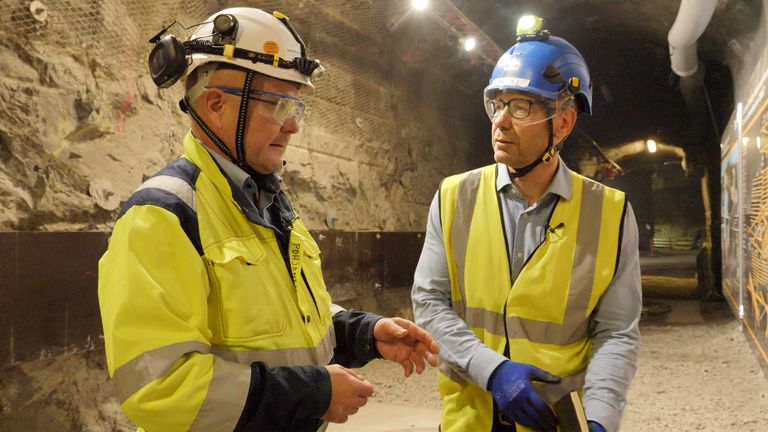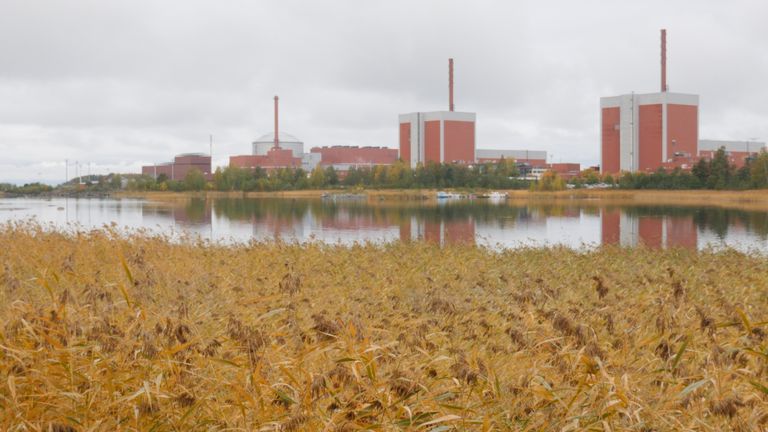The world’s first nuclear waste geological grave is rapidly forming more than 400 meters below a Finnish forest.
A deadly shipment of radioactive uranium will begin arriving within two years, buried in the tunnel Warren carved into the bedrock.
Other countries, including the UK, are considering plans to build their own geological disposal facilities, which should be able to safely isolate the 260,000 tonnes of highly radioactive waste that has accumulated globally since the birth of nuclear power in the 1950s.
Sky News was given access to the site, which is called Onkalo, which means “cave” in Finnish.it was built next to three nuclear Reactors on the country’s southwest coast.
Security was so tight after the incident Sabotage the Nord Stream natural gas pipeline There are strict no-shooting rules on the ground.
But we were taken down a 5km passage that meanders through bedrock so deep that our ears burst.
At the bottom, more tunnels fan out. So far, five have been completed, but as many as 100 may be built in the coming decades, with a total length of more than 40 miles.
Our guide was Sanna Mustonen, a geologist and senior project manager at Posiva, the company that operates the facility.
The bedrock formed nearly 2 billion years ago and has remained intact since then, she said.
“The rock itself, like in the whole area Finlandvery stable,” she said.
“We have ancient rocks. We don’t have continental plates near us, so we don’t have any earthquakes, seismic activity or anything like that.”
‘There must be security’
Like other countries, Finland is storing spent nuclear fuel on the ground in shielded bunkers as it seeks a long-term solution.
But Posiva’s managing director Mika Pohjonen said it was irresponsible to leave such hazardous waste where it could end up in the wrong hands.
He told Sky News: “If you look back 300 years ago, for example, how many wars were there in Europe?
“On the surface, interim storage requires active human action, buildings need to be heated, spent fuel must be cooled, and there must be safety measures around.
“If you look a generation ahead, you really don’t see the arrangement being risk-free enough.”
Various solutions to the problem of nuclear industry waste have been proposed, including launching it into deep space, burying it in an ocean trench, and placing it in cracks in the Earth’s crust.
They were dismissed as infeasible, expensive or risky to the environment.
“Safe for a million years”
Instead, Posiva will pack spent nuclear fuel into double-layered metal canisters that will be inserted into boreholes at the bottom of the tunnel.
To keep them dry, they’ll be wrapped in bentonite clay, an absorbent material used in cat litter.
More bentonite will be used to backfill the tunnel, which will be blocked with concrete.
When the complex fills up in about a century, possibly with as many as 3,250 jars, it will be sealed and all traces removed from the ground.
“It will be safe for a million years,” Mr Pohjonen said.
“There may be no more humans here, because then there will be an ice age or [this area will be] Underwater, but this is to keep it out of the biosphere. “
The fake tank has been buried in bentonite and surrounded by sensors.
Some scientists have warned that water can corrode metals, become radioactive and then surface over thousands of years.
But Posiva says multiple barriers keep waste out. In the very unlikely worst-case scenario of a leak, models show that when any water reaches the surface in 10,000 years, the radioactivity will decay so much that it doesn’t pose a threat to life.
Finland’s progress is closely watched by other countries. Sweden has started building its own deep geological disposal site. France, Switzerland and the UK are further behind.
A shortlist of four possible locations has been drawn up in Cumbria and Lincolnshire.
read more:
New nuclear power plant gets government approval for development
Radioactive sludge removal begins in Western Europe’s most dangerous building
Bruce Cairns, chief policy adviser to the UK Nuclear Waste Service, also visited Onkalo while we were there.
He said the responsible and permanent disposal of waste was crucial as the country commissioned a new generation of reactors.
“We have 70 years of waste in the UK that has accumulated from energy production, defence and industrial processes.
“It’s not going anywhere unless we do something about it. We have to act to make sure this is managed responsibly, not just now, but in the long term.”
The key to Finland’s progress is engagement with local communities.
locals agree
The closest settlement is Eurajoki, about 10 miles away.
Existing nuclear reactors are already big local employers, and when the region was selected from a shortlist for a disposal site, local authorities voted overwhelmingly in favour.
“We’ve had nuclear power here for 40 years,” said the town’s mayor, Vesa Lakaniemi.
“People know that nuclear and ultimately [waste] Disposal is much more than in areas without nuclear power plants.
“Trust has grown for four decades.”




